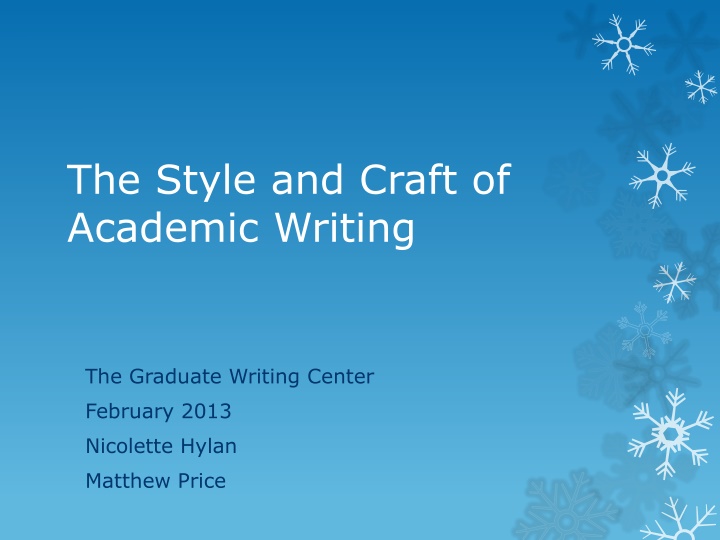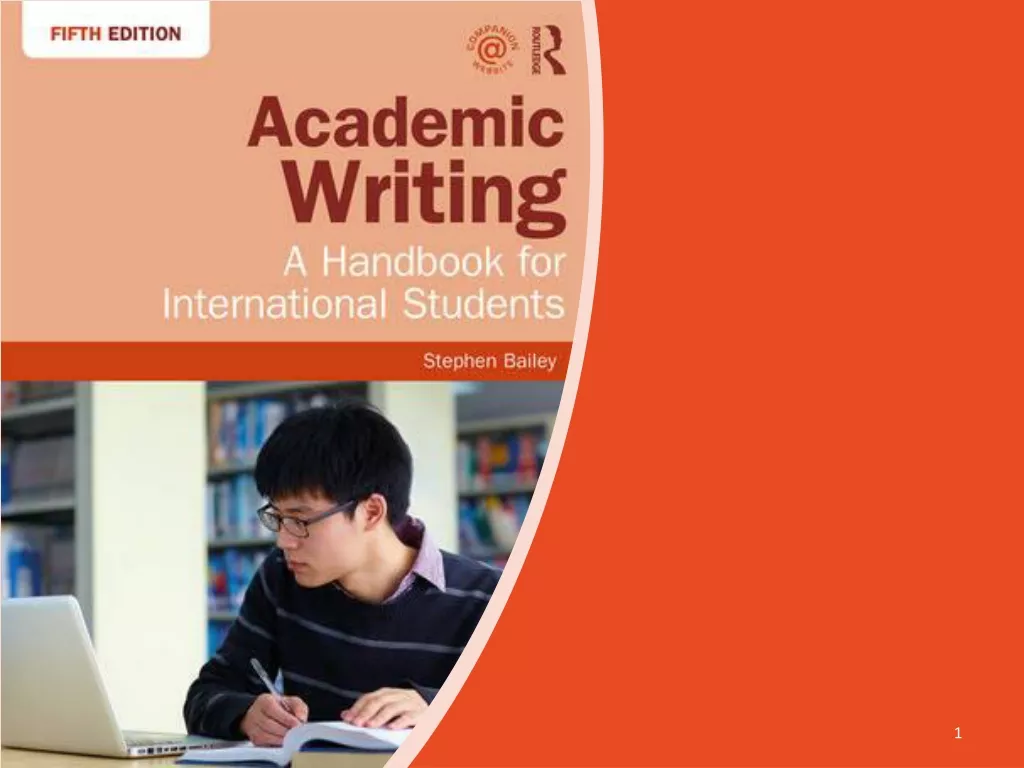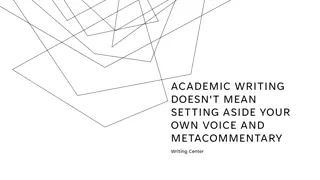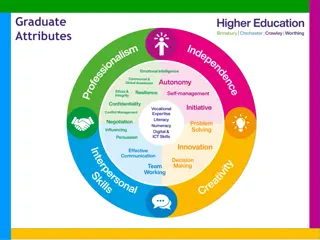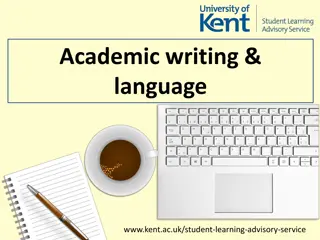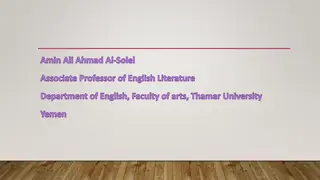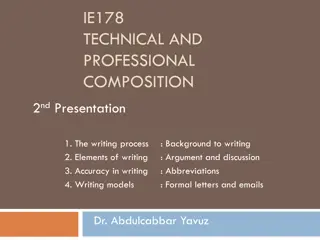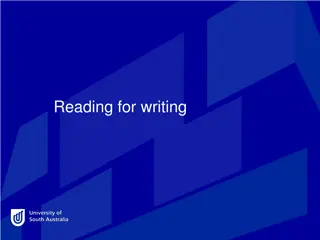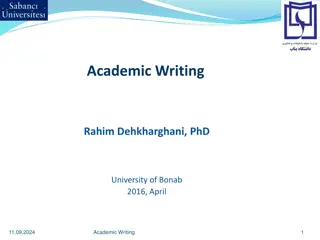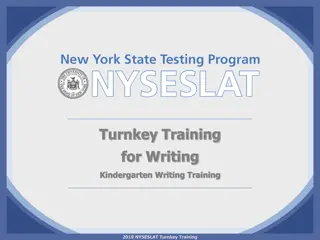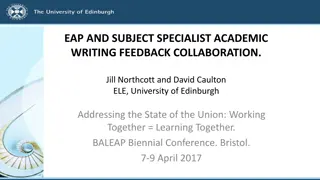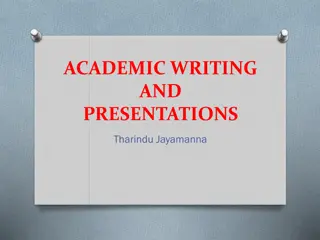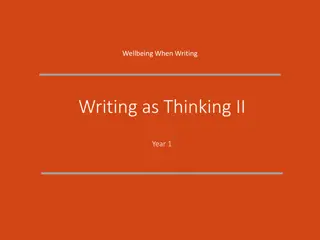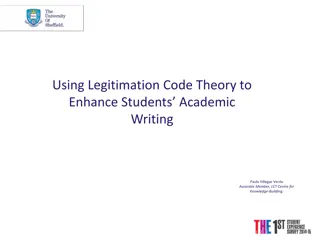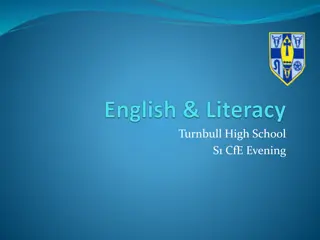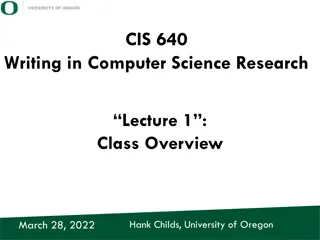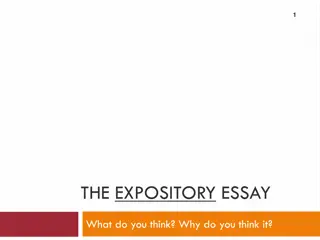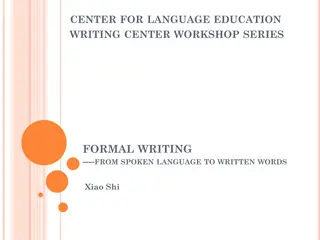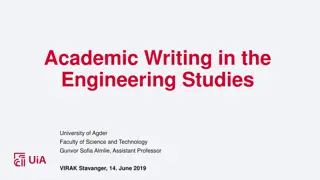Enhancing Academic Writing: Strategies and Techniques
Explore strategies and techniques for improving academic writing at the paper, paragraph, and sentence levels. Learn about organizing principles, signposting, paragraph development, and effective topic sentences. Discover tools to address common pitfalls in academic writing and enhance your writing skills.
Download Presentation

Please find below an Image/Link to download the presentation.
The content on the website is provided AS IS for your information and personal use only. It may not be sold, licensed, or shared on other websites without obtaining consent from the author.If you encounter any issues during the download, it is possible that the publisher has removed the file from their server.
You are allowed to download the files provided on this website for personal or commercial use, subject to the condition that they are used lawfully. All files are the property of their respective owners.
The content on the website is provided AS IS for your information and personal use only. It may not be sold, licensed, or shared on other websites without obtaining consent from the author.
E N D
Presentation Transcript
The Style and Craft of Academic Writing The Graduate Writing Center February 2013 Nicolette Hylan Matthew Price
The Graduate Writing Center One-on-One Consultations All types of writing, all stages of the process Hours for the coming week posted Friday, 4PM To schedule, see the Center s website: https://composition.la.psu/resources /graduate-writing- center/GWC Freelance Editing Services Available Upon Request
Workshop Goals To introduce stylistic concerns on three levels: paper, paragraph, and sentence To give you tools and solutions to address common pitfalls in academic writing To facilitate discussion of sample mistakes among all disciplines/fields present at the workshop
Paper-Level Concerns Matching Organizational Principles (Logic) to your Field Common expectations for assignment format? How do writers in the field draw the reader in? What are the citational expectations for the field? The Solution: Read more examples, study their stylistic conventions! Example questions to ask: How does X organize its sections? What serves as the introduction? What makes it interesting/memorable/compelling?
The Challenges of Signposting Signposting: the use of explicit explanations of where the paper is/where it s going (clarifying paper s logic) Authorial contract (Promise): In this paper, I aim to (contend/argue/posit) This study will examine Don t overuse the personal know your field s conventions Textual Features: In order to understand A, one must first analyze B Contrary to point A, I would like to suggest point B. This study can now move from A to B
Paragraph-Level Concerns Effective paragraphs are: Well-developed They avoid making assumptions. Cohesive Their ideas connect to one another (transitions). Coherent They clarify the logic of the paragraph (topic sentences).
Topic Sentences A topic sentence accomplishes the following tasks: Expresses a claim (not a fact) that supports the thesis Indicates the content of the paragraph (central idea) Creates a transition from the previous paragraph Maintain proper pacing (long/short sentences, etc.). Ex: Although previous studies of weather patterns have focused on rain and wind, this study proposes an analysis of tornado formation. Ex: However, these studies have neglected the importance of tornado formation. Ex (Avoid): Tornado formation is a major problem.
Transitional Words and Phrases Transitions signal relation between sentences, paragraphs Know relationship between the sentences/paragraphs! Addition (furthermore, more importantly, additionally, etc.) Contrast (however, conversely, on the other hand, etc.) Time Order (previously, subsequently, simultaneously, etc.) Avoid multiple transitions/introductory clauses On the other hand, however, although the study Furthermore, where the study subsequently did Avoid beginning with coordinating conjunctions (for, and, nor, but, or, yet, so)
Referencing Sources Citations/references allude to previous work or valuable sources. Know the conventions of your field. Style Guides, Published Work, Etc. Follow the guidelines for particular journals when publishing Know how and when to use references, quotations. Avoid quoting to start/end paragraph. Work quotes into your own sentences.
Sentence-Level Concerns Effective sentences will: Use active voice and clear, strong verbs. Build a balanced hierarchy of ideas. Use punctuation and quotes effectively. Remember: The goal is to make your reader understand (and be persuaded by) your prose.
Integrating Quotes/Citations Quotes must be worked into your sentences. Ex: According to John Smith in his recent study, weather patterns dictate the very fabric of our lives. Ex: Many New Yorkers like Jane Smith found their lives forever altered by the Snowpacalypse: We had no power, no food, no hope, really, for nearly a week. Her testimony was a common refrain among the community. Ex (Avoid): Weather is dictates the very fabric of our lives in Smith s study. Studies must be cited according to field s conventions. Ex: Smith (2001) proposes a new mode of weather analysis. Ex (Avoid): Smith (2001) proposes a new mode of weather analysis.
Active Voice versus Passive Voice The active voice relates subjects to verbs explicitly( I made a mistake ). The passive voice uses a to be verb and a past participle ( Mistakes were made ). Use active language, unless passive voice is necessary for cohesion, rhythm, or disciplinary conventions. Active Voice: Captain Ahab s monomania drives him to pursue Moby Dick. Previous studies demonstrate the importance of weather analysis. Passive Voice: Moby Dick is pursued by the monomaniacal Captain Ahab. The importance of weather analysis has been demonstrated.
Verb Choice and Usage Verbs often determine the clarity/descriptiveness of academic writing. You should: Avoid weak linking verbs. Avoid: Psychology is a field with a number of subfields involving child and human development. Ex: Psychology has a number of subfields involving child and human development. Choose more precise verbs to shorten sentences. Avoid: This study is involved in asking whether we should continue our current national economic policies. Ex: This study interrogates our current economic policies.
Balancing Subject, Verb, & Object Typical English sentences maintain a subject-verb-object order. Strong sentences will: Avoid lengthy subjects. Avoid overusing ing verbs. Ex (Avoid): Going to the store after working out to buy Gatorade and something to eat is my favorite part of it. Ex: I like going to the store after working out. Ex: (Avoid): Measuring temperature correctly is imperative for designing weather-related studies.
Using Clauses and Appositives If you have an introductory clause, remember that the main (independent) clause is still most important. Ex: Although weather-related analyses continue to grow, new tools and methods need to be implemented. Ex (Avoid): Although weather-related analyses continue to grow and new methods need to be implemented and studied for long-term value, it is not enough. An appositive is a noun or noun phrase placed next to another word/phrase to identify or rename it. Usually, the second one is the longer one. Ex: Jim, my friend from home, is coming to town. Ex (Avoid): My friend from home who was in my wedding, Jim, is coming to town.
Persuading through Punctuation By using punctuation strategically, you can make complicated sentences more manageable for your readers. It influences emphasis, pacing, and flow. A colon introduces a list or emphasizes what comes after Ex: The study opened three new fields: A, B, C . Ex: The results suggest a shocking conclusion: we have yet to fully determine the cause of tornadoes. A semicolon stands between two independent clauses Ex: Great Expectations ends with a death; David Copperfield begins with one. Avoid: Great Expectations ends with a death; contrary to David Copperfield.
Punctuation Continued The long dash (em-dash) allows you to interject in your own sentence perfect for making little additions. Ex: Johnson (2001) a study on bat migration patterns remains a pivotal study for animal researchers. Ex: These studies remain underappreciated even when we acknowledge their frequent citation in other works. Parentheses work similarly to the long dash (extra info). Ex: Johnson s study (which was awarded with a national grant) remains a pivotal one for animal researchers. Remember: Multiple punctuation marks can stand in the same place. Your choice depends on your persuasive purpose!
